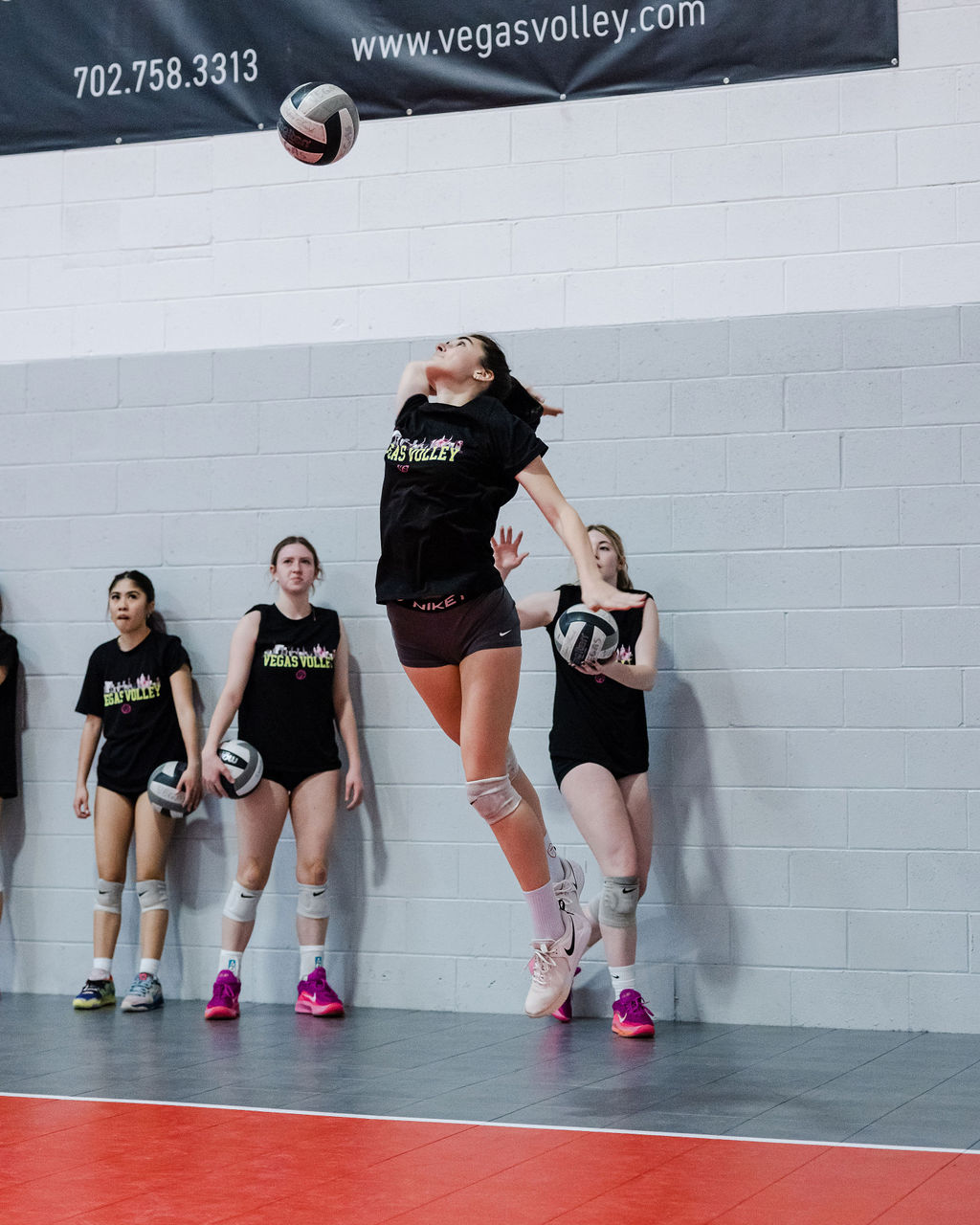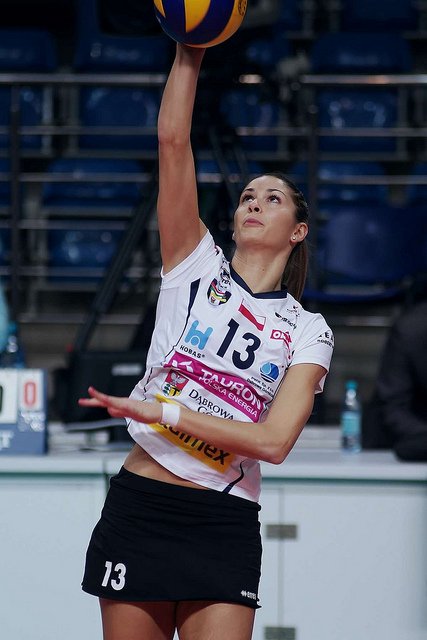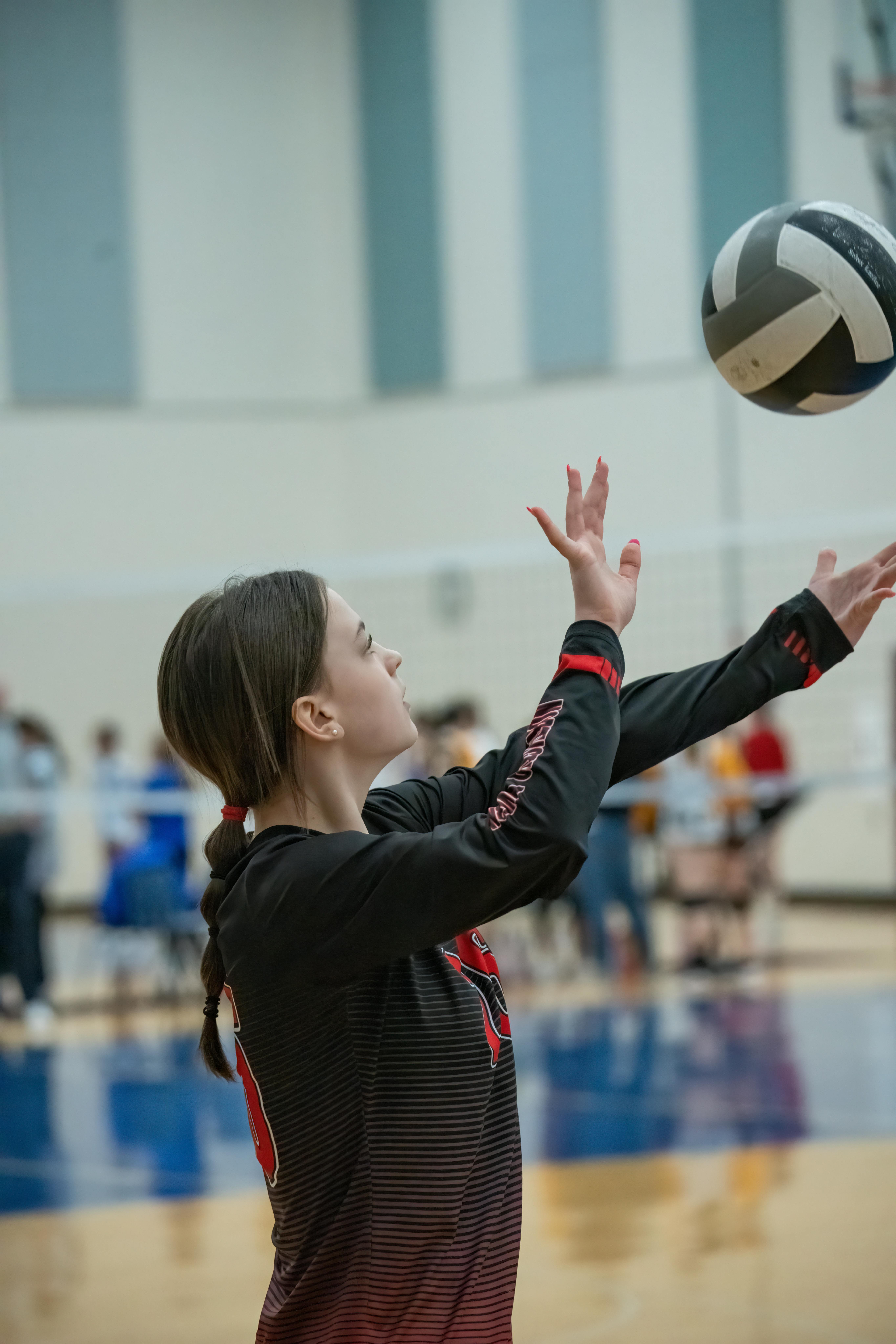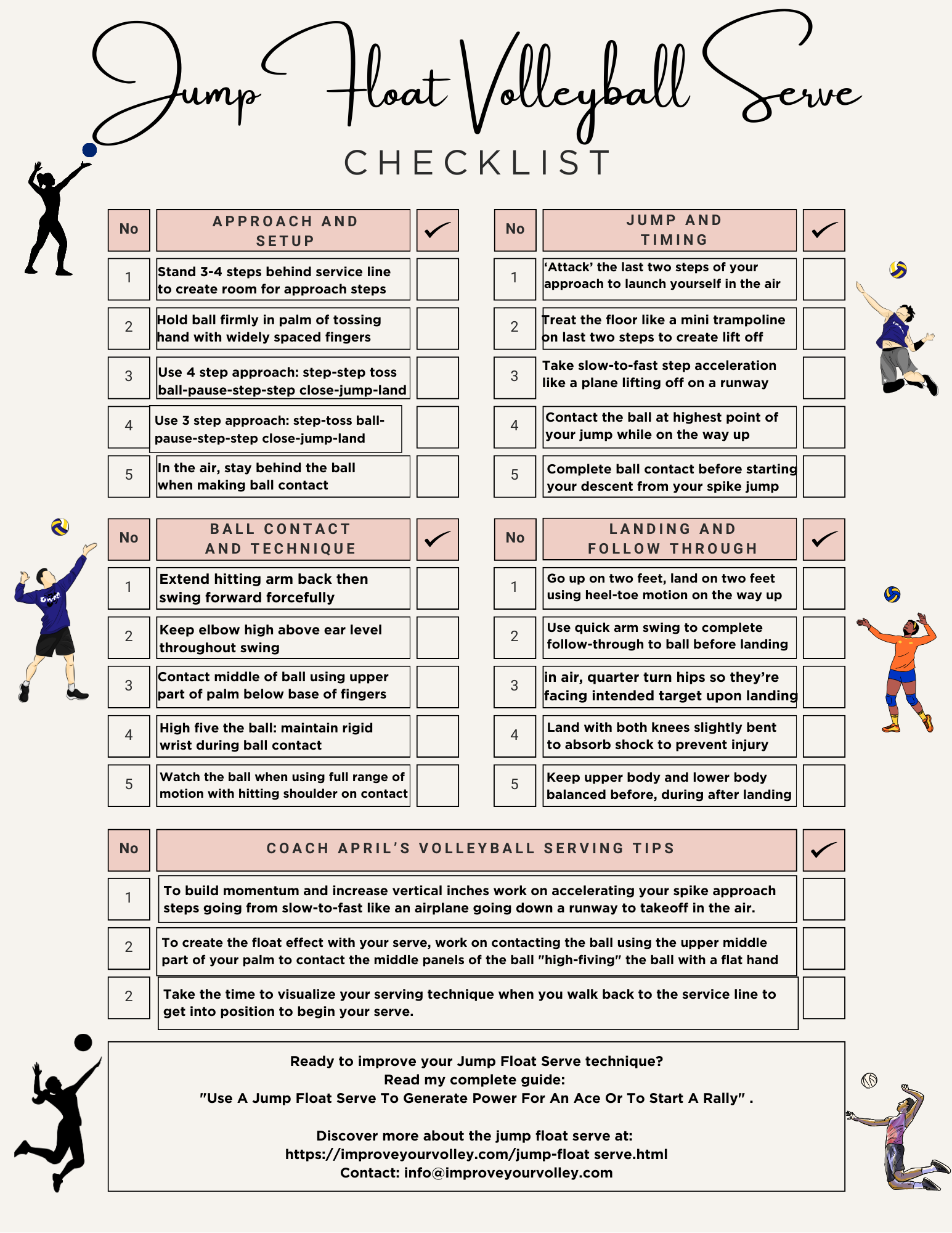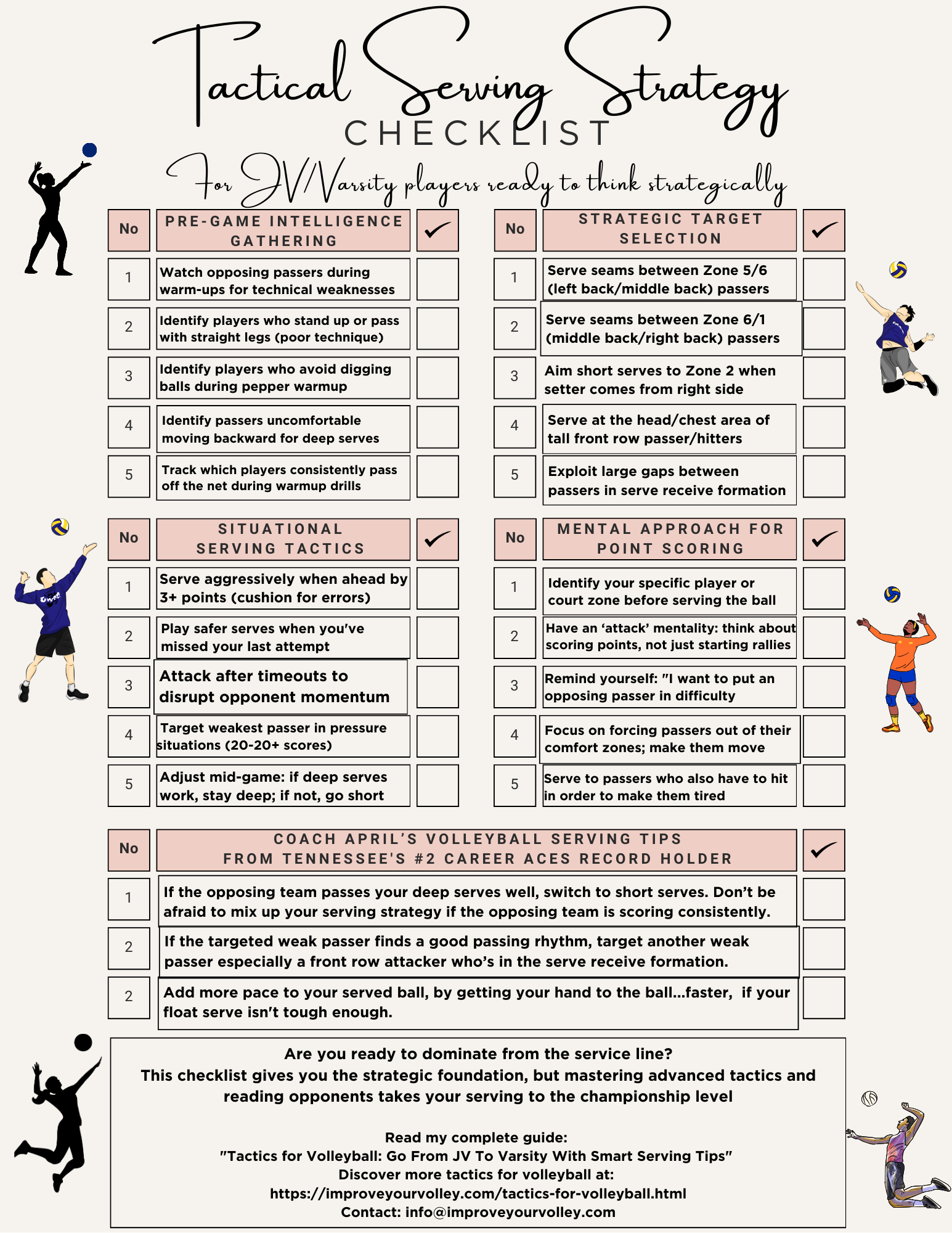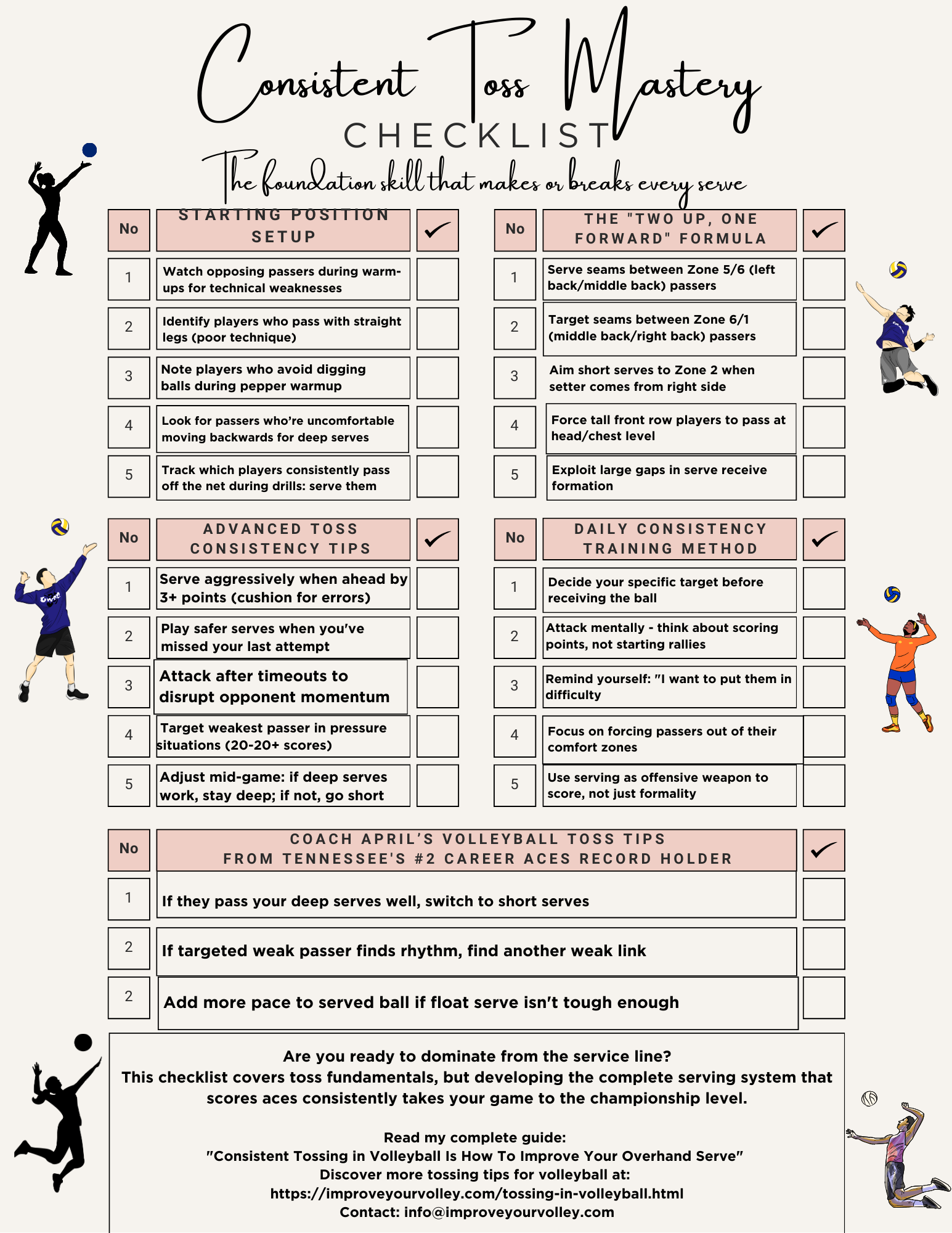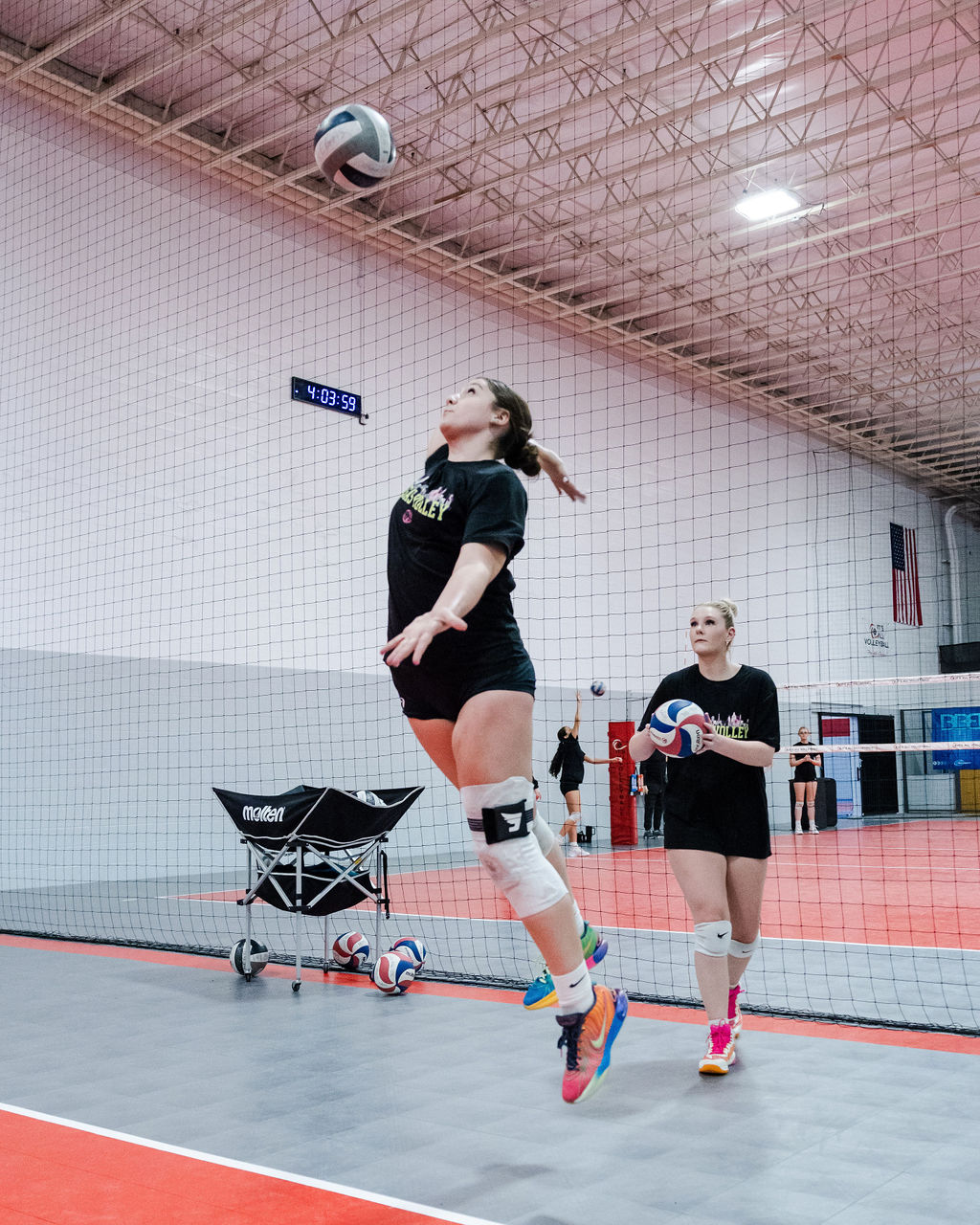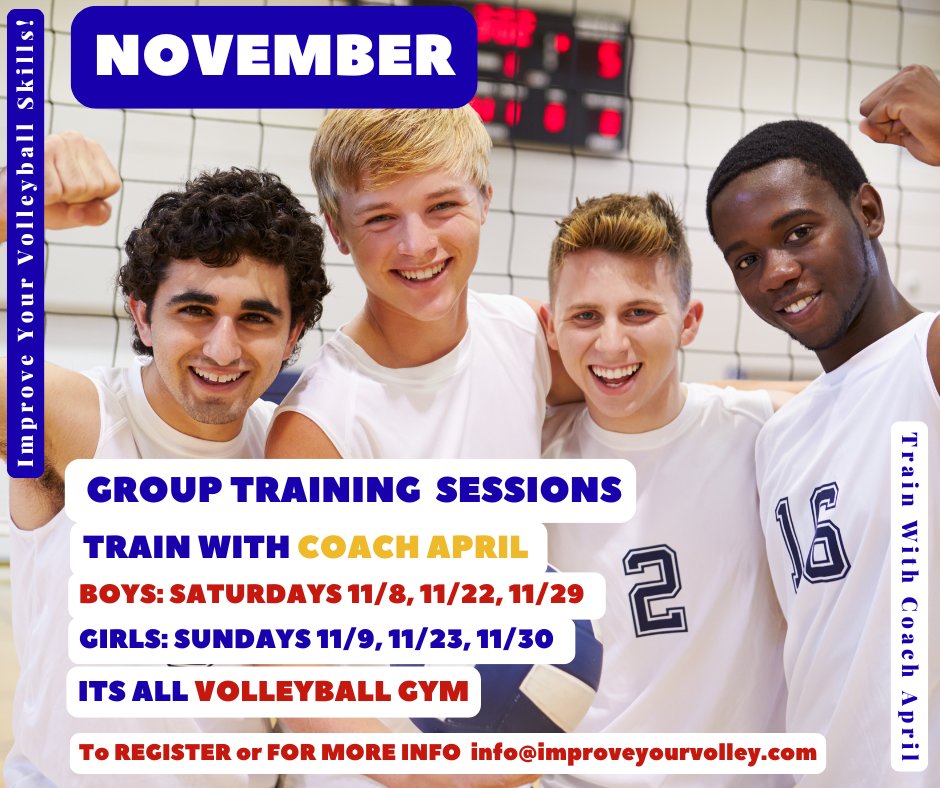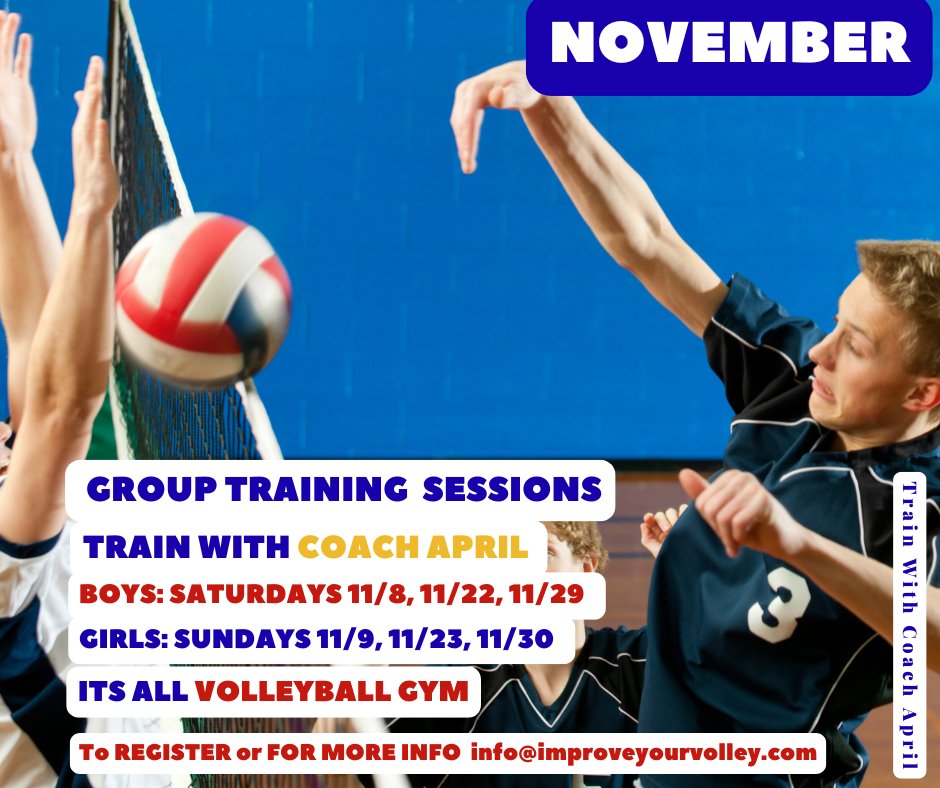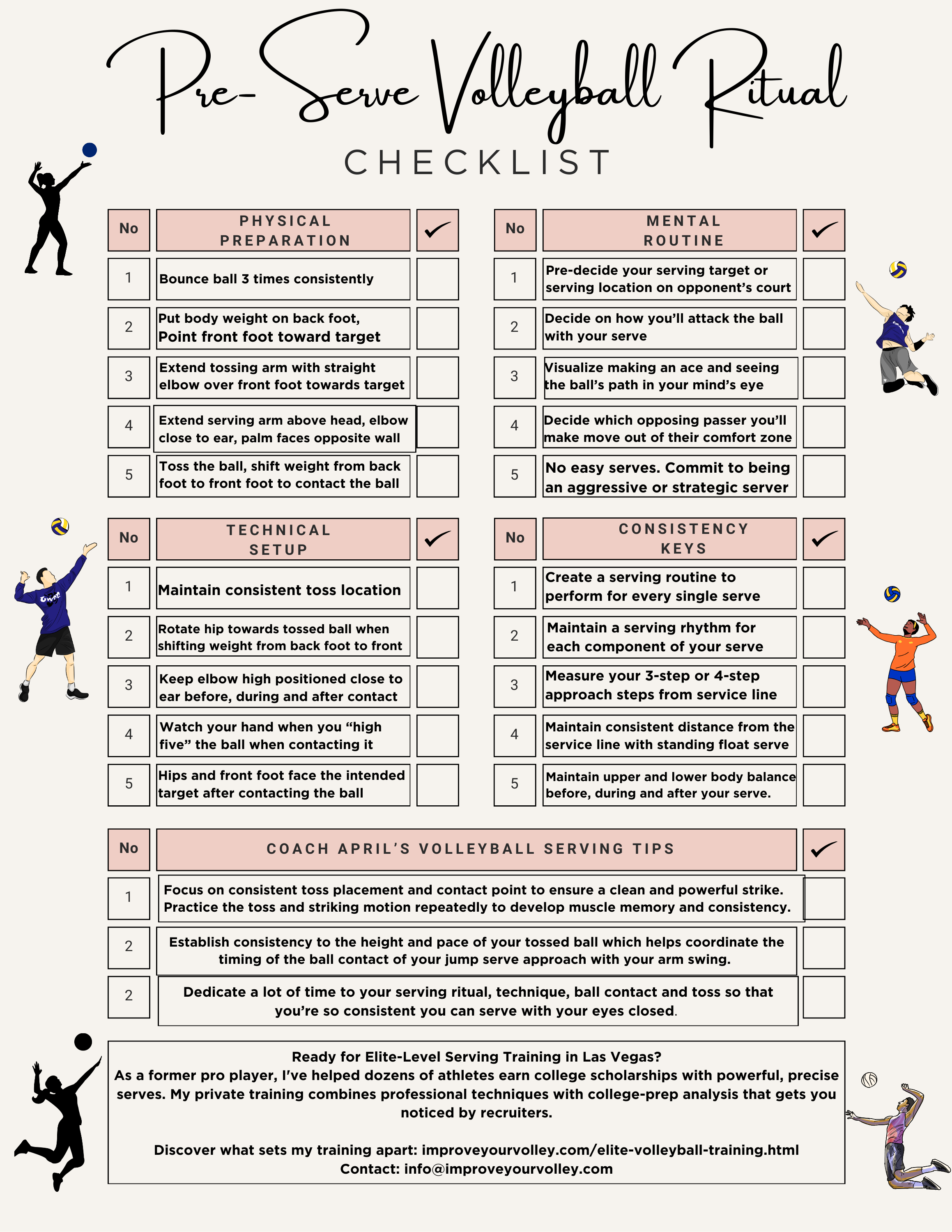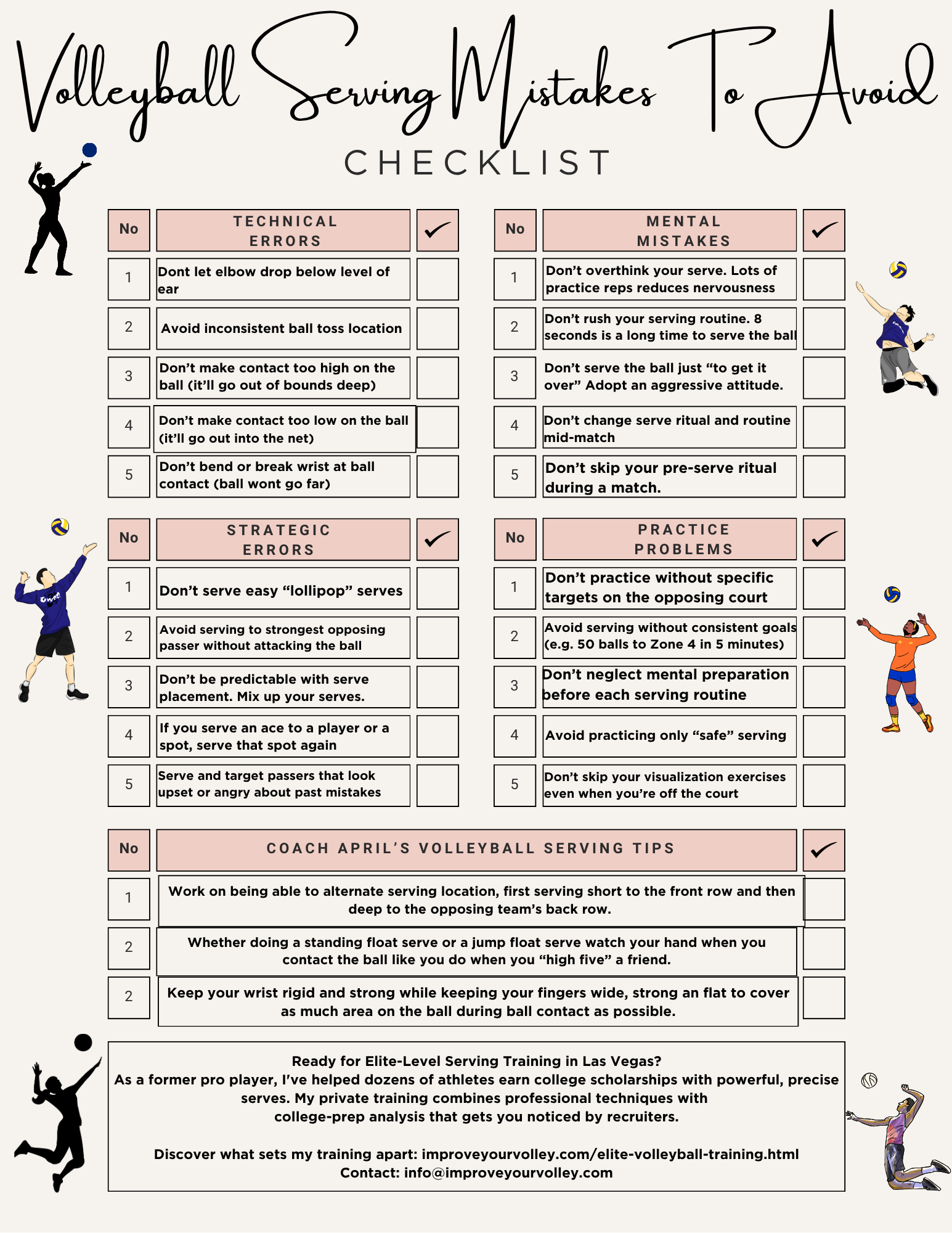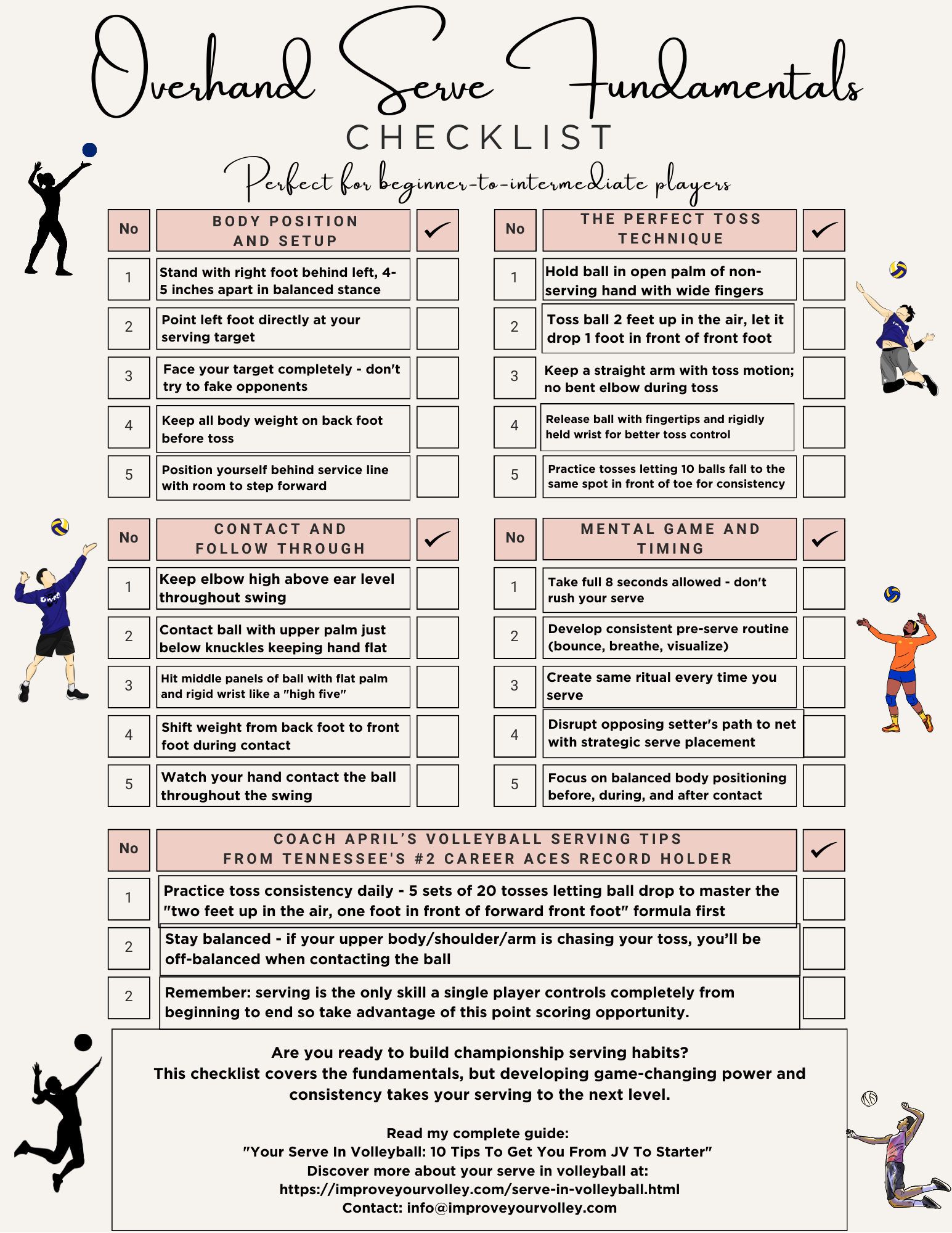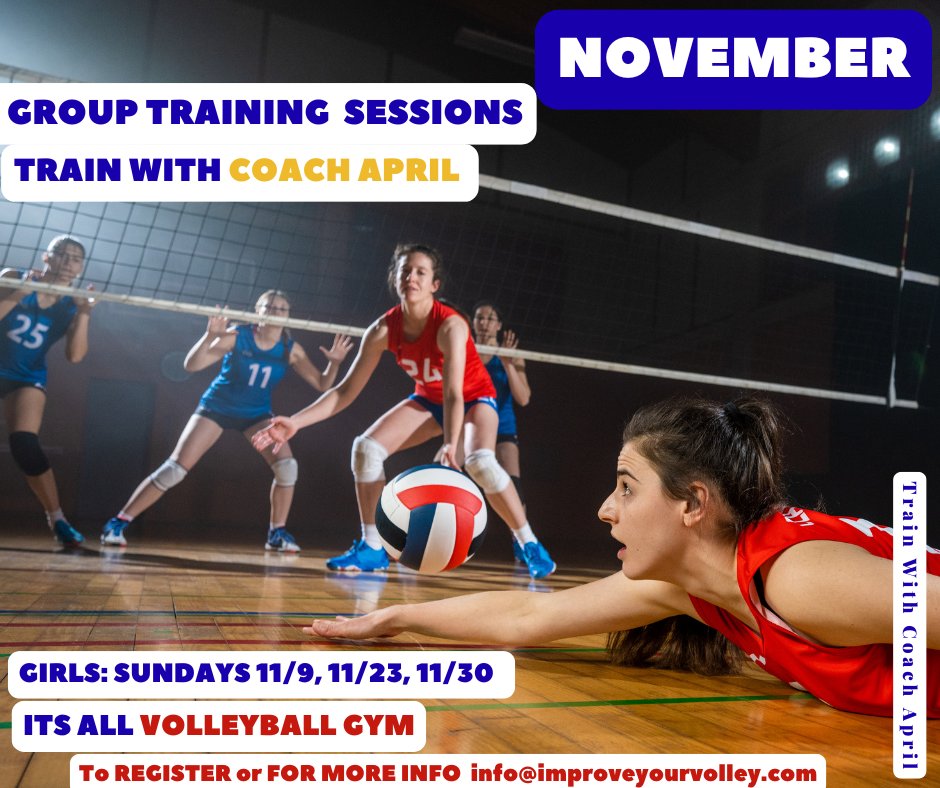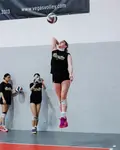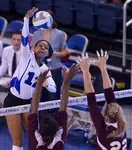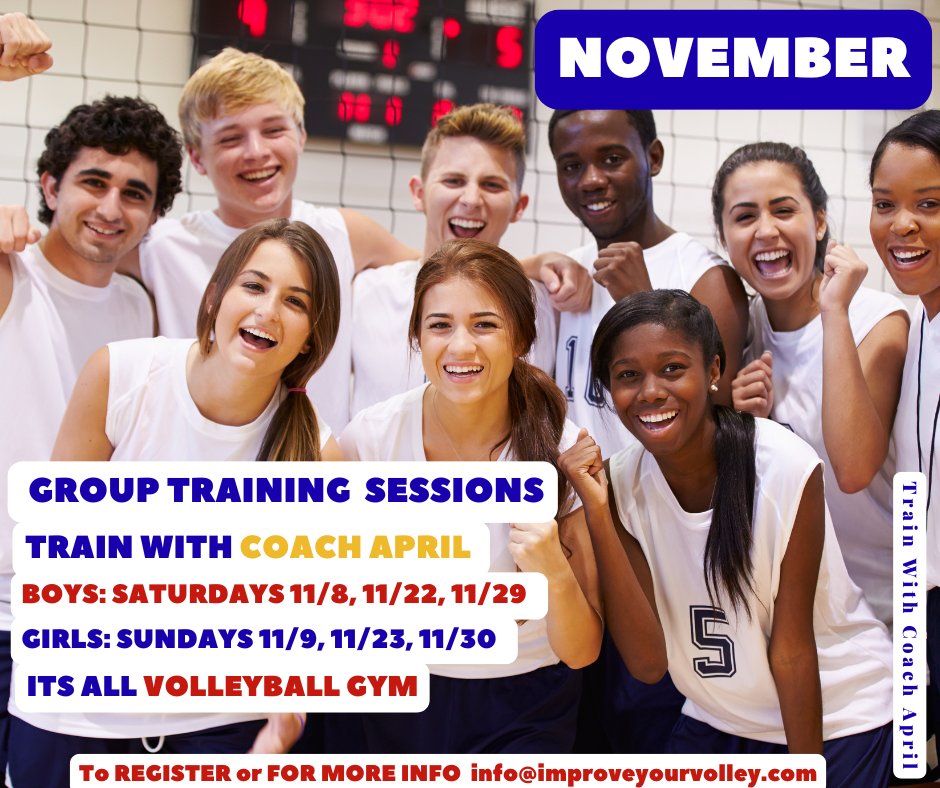 NOVEMBER Group Training with Coach April
Registration is NOW open for Group Training Sessions with me Coach April For BOYS on SATURDAYS 11/8, 11/22, 11/29
For GIRLS on SUNDAYS 11/9, 11/23, 11/30
From 10-11am at the Its All Volleyball gym.
Email: info@improveyourvolley.com to register or for more information
NOVEMBER Group Training with Coach April
Registration is NOW open for Group Training Sessions with me Coach April For BOYS on SATURDAYS 11/8, 11/22, 11/29
For GIRLS on SUNDAYS 11/9, 11/23, 11/30
From 10-11am at the Its All Volleyball gym.
Email: info@improveyourvolley.com to register or for more information- Improve Your Volleyball with Coach April
- High School Varsity Volleyball
- How To Jump Float Serve
How to Jump Float Serve: 3 Pro Volleyball Player's Secret Serving Tips
Why do college players rely on the jump float serve? It combines power with unpredictable movement. Learn how to jump float serve like the pros in this guide.
Think about the last volleyball match you watched.
- Which players got the most playing time?
- Weren't they the ones who could consistently score points from the service line?
In volleyball, your serve is the only skill where you have complete control from start to finish - no teammates to rely on, no opposing blockers to worry about.
That's why mastering different serve types isn't just helpful; it's essential for any player who wants to make a real impact on their team.
Lets Find Out
How To Jump Float Serve Correctly
Your Body Positioning For The Jump Float Serve: What Should It Be?
How To Jump Float Serve...The Way I Teach It
Addi works on her jump float serve toss consistency while aiming for a deep line serve to Zone 5.
- Stand behind the service line with...
- Feet shoulder-width apart in the shape of the letter 'L" with your front foot pointed where you plan to serve and your back foot perpendicular to the front foot.
- your serving arm extended above your head with the palm of your hand facing the wall on the right side of your body
As a right handed server...
- line your body up to face your serving target
Your body will be parallel to the service line.
Whether you're serving to a court zone or directly to an opposing player...face your target.
Let the player know...you're coming right at them with your serve.
Decide Early Where You're Going To Serve How To Jump Float Serve
Toni with the Overhand Float Serve During
My Happy Hour Class Training
An important key for a server to remember is to make a decision early and decide where you are going to serve before you serve, then turn and point your toe and your tossing arm, straight at your serving target.
Sometimes your coach will make the decision for you and tell you where to serve by "calling the serve" with their finger by holding up a number that represents a zone on the opposing team's court to serve to.
If they don't "call the serve" then you need to formulate a plan in your head based on either
-where to serve to on the court or -who to serve to
so that you raise the possibility of scoring an ace which is a direct point by yourself for your team.
Ready to take your serving to the next level?
I help college-bound servers who want to add the jump float to their tool box...with me you'll master this elite serve without sacrificing your current serving strength with my advanced training that makes you a dual-threat server that college coaches covet.
My private training sessions are specifically designed for college-bound athletes who refuse to settle for "good enough" serving.
Limited spots available for serious players only.
How To Jump Float Serve:
What Is Strategic Serving?
How do you do this? Look for...
- who just made the last error on the court
- which passer looks nervous or looks angry or insecure
- which player in serve receive is not talking to other passers
- look for large seams or empty areas on the court
Strategic serving also can mean for you to look to see
- if the opposing team is made up of short players consider serving a deep serve in their court to force them to move backwards and to stay deeper in the court
- if the opposing team is made up of taller players (who usually) move slower than shorter players consider serving a short serve that forces tall passers to have to move forward to pass...which means their spike approach runway is made shorter so they don't have as much time to back up, shuffle outside and take their usual 3 or 4 step spike approach
Players are given a specific amount of time to serve a pre-determined number of balls to the target area formed by the chairs. hitting the middle of the chairs is rewarded more than just hitting the chairs in this case but coaches can come up with their own rules in in order to make this a tougher or easier drill.
Your Serving Arm Ready Position
Katelyn with the
Tough Jump Float Serve
Right Handed Serving Arm
- Raise your serving arm so its in a 90 degree angle with a bent elbow and open palmed hand, above the level of your right ear.
Many servers have problems serving over the net because they drop their elbow during their serving swing in an attempt to shot put the ball over the net
Keep your elbow above the level of your ear!
The Palm of Your Serving Arm Should
Face The Opposite Wall
- Keep a flat palm with fingers spread wide, as if you are about to give a teammate a high five
- Your flat hand should be as flat as a ping pong paddle.
My College Breakfast Club training group working on jump float serve skills specifically hand to ball and toss consistency.
Once you've mastered the fundamentals of the standing float serve, let me ask you this:
What if you could add even more power, speed and deception to your serving game? That's exactly what the jump float serve does.
It's a dual threat – combining the unpredictability of the float with the power from a jump.
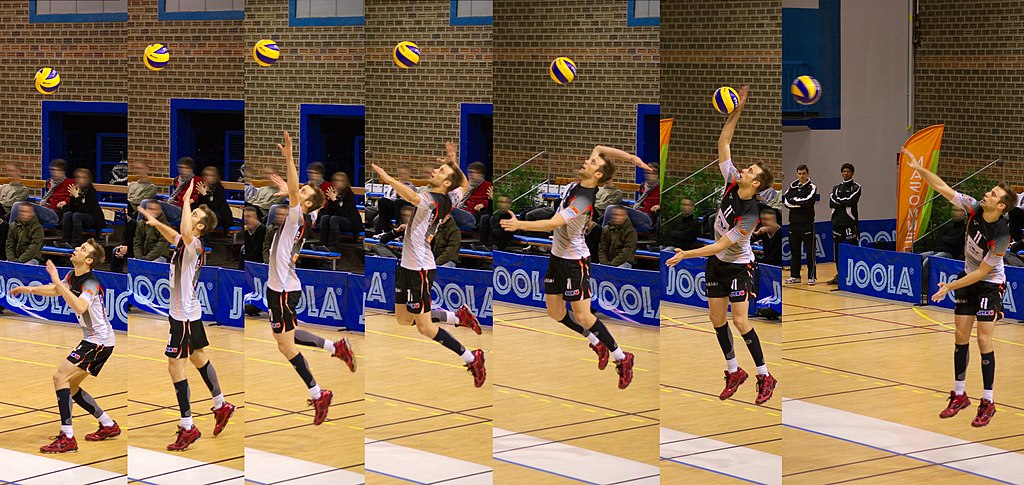 The jump gives your serve more power pace and angle, while the float characteristics make the ball's path tricky to predict.
Opponents find themselves guessing where the ball will land, making it a challenge to return effectively.
The jump gives your serve more power pace and angle, while the float characteristics make the ball's path tricky to predict.
Opponents find themselves guessing where the ball will land, making it a challenge to return effectively.Ask any coach: Would they rather have a server who's predictable or one who keeps opponents guessing?
The jump float serve ensures you're always the latter.
Learning the Jump Float Serve Technique:
Controlling Your Body In The Air
- Start 3 - 4 steps behind the service line. This gives you room for your serving approach steps whether you take three or four steps
- The serve approach is usually three steps: left-right-left (or right-left-right for lefties).
- As you take your first step forward, while your momentum is moving you forward then toss the ball up and slightly in front of you so that when you take your next steps ..you stay behind the ball.
- So to be clear the cadence would be for a right hander left step - toss the ball - right step - left step or for lefties then you'd take a right step-toss-left step-right step
- During your lift-off in the air, jump using a heel-to-toe motion with your feet to help you get elevated into the air quickly...just like an airplane you gather speed with each step as you move down your runway....before you actually lift off...into the air
- Just like the standing float serve your tossing arm with palm up cradles the ball and your serving arm is extended above your head so your arms in this position for the shape of the letter "L"
- At the height of your jump and keeping your elbow high above the level of your ear and palm facing the right wall, position your serving flat "high 5" hand for a firm, flat contact with the ball, just like with a standard float serve.
- Just like the standing float serve your tossing arm with palm up cradles the ball and your serving arm is extended above your head so your arms in this position for the shape of the letter "L"
- At the height of your jump and keeping your elbow high above the level of your ear and palm facing the right wall, position your serving flat "high 5" hand for a firm, flat contact with the ball, just like with a standard float serve
Ready to take your serving to the next level?
I help varsity athletes who rely on power serves add next-level strategic serving without sacrificing their ace count through proven techniques that showcase elite serving IQ on recruitment videos.
My private training sessions are specifically designed for college-bound athletes who refuse to settle for "good enough" serving.
Limited spots available for serious players only.
When You Learn How To Jump Float Serve And Making It Work For You
Opponents find themselves guessing where the ball will land, making it a challenge to return effectively.
Three Common Tips On How To Jump Float Serve Effectively
My private clients are given a specific amount of time to serve a pre-determined number of balls to the target area formed by the chairs.
Hitting the middle of the chairs is rewarded more than just hitting the chairs in this case but coaches can come up with their own rules in order to make this a tougher or easier drill.
Here are three tips you should pay attention to ...
Slow To Fast Serve Approach Steps
Slow to fast....
- The timing of your steps for your serve approach should go from slow-to-fast with an aggressive "step close" (the last two steps of your approach before lift-off) while staying behind the ball when you swing
Contact The Ball At The Highest
Point Of Your Jump
Contact the ball at the highest point of your jump...
- Make contact with the ball - either on the way up or at the highest height of your vertical jump but not on the way down from your jump
Watch Your Hand When Contacting The Ball
Watch your hand...
- Watch your hand when you're contacting the ball. Contacting the ball too low or too high can throw off your ability to control the final destination of where the ball lands and it may affect the amount of float and spin movement on the ball
Click to Download Your Jump Float Volleyball Serve Mastery Checklist pdf:
🎯Jump Float Volleyball Serve Mastery Guide - $7
Are you attempting jump float serves but lacking the technical precision that creates consistent power and accuracy? Why Struggle with Jump Float Serves When You Could Master Them Systematically?
You'll Get:
Approach and Setup Methods --Master 3-step and 4-step approaches with optimal spacing and ball positioning
Jump and Timing Techniques -Perfect the slow-to-fast acceleration that creates maximum vertical lift and power
Ball Contact Fundamentals Learn the "high five" contact method for consistent float effect and accuracy
Landing and Follow-through Execute safe two-foot landings with proper hip rotation and shock absorption
Click to Download Your Tactical Serving Strategy Checklist pdf:
🎯Tactical Serving Strategy Checklist Guide - $7
Are you serving without strategic purpose while opponents easily run their offense? Why React to Opponents When You Could Be Controlling Them?
You'll Get:
Pre-game intelligence methods --Identify technical weaknesses and poor passing habits during opponent warm-ups
Strategic target selections Master seam serving and zone targeting that creates immediate passing problems
Situational serving tactics Know when to serve aggressively vs. safely based on score and game situation
Mental approach strategies Develop point-scoring mentality and force passers out of comfort zones
Coach April's tactical tips Adjust serving strategy mid-game and target front-row hitters effectively
1-page PDF checklist Convenient format you can print or keep on your device for strategic reference
Click to Download Your Consistent Toss Mastery Checklist pdf:
🎯Consistent Toss Mastery Guide - $7
Are inconsistent tosses sabotaging your serves and forcing you to chase the ball? Why fight your toss when you could master the foundation of every great serve?
Three Common Mistakes To Avoid When Learning How To Jump Float Serve
Adding Wrist Snap Instead of
Keeping a Stiff Wrist
Keep your wrist rigid...
The jump float requires a firm, flat hand contact - like a "high five."
Many players instinctively snap their wrist (from their attacking habits), which adds spin and eliminates the unpredictable float movement that makes this serve effective.
Inconsistent Toss Height and Location
Inconsistent toss...
Unlike the high toss for topspin, the jump float needs a consistent, controlled toss just high enough for your approach timing.
Tossing too high forces you to wait, losing momentum. Tossing too far forward pulls you past the service line.
Contacting the Ball On The Way
Down from Your Jump
Quicken your armswing and hit the ball on the way up...
For maximum power and control, contact the ball at the peak or just before the peak of your jump.
Many servers contact the ball on the way down from the toss, reducing velocity and causing the ball to drop short.
This happens when players rush their approach or mistime their jump.
A Tip From (Me!) Coach April
Guess What? I Have Another
How To Jump Float Serve Tip For You
To produce a faster more powerful jump float serve make sure that you 'attack the floor' on those last two approach steps that you take before 'lift-off'.
I remind my players, that a strong lower-body push off the floor will help you lift up off the ground higher and will help you make an aggressive 'flat-hand stiff wrist" ball contact when you're mid-air.
Every extra inch you gain in your jump translates to the possibility of creating more power and pace that pushes the ball over the net faster and with more float and dip movement making it a difficult serve to pass.
Three More How To Jump Float Serve Tips To Consider...
- I always emphasize keeping your hips open to the right during the last two steps of your approach, especially when serving down the line.
- A consistent toss will make everything smoother.
- Keep your eye on the ball, just like Addi, who practices 100 overhand serves. It’s all about those reps!
How To Jump Float Serve:
Make Yourself A Better Server
Here's a question every serious player needs to answer:
Are you willing to put in the practice time to master these three different volleyball serve types, knowing it could be the difference between starting and sitting on the bench?
Here's where the rubber meets the road.
It's not just about knowing about these volleyball serve types players use in a match but actually getting good at performing them so they feel like second nature out on the court.
How To Jump Float Serve:
Practice Makes Perfect
- Dedicate time every practice to each serve type. Start with 20 reps of each then gradually increase.
- Focus on one type per session to really internalize the method.
Avoid Overthinking
While practice is essential, don't get too caught up in perfection. Allow yourself to make mistakes – they’re just lessons that help you get better.
How To Jump Float Serve:
Simulate Game Scenarios
Use practice to mirror game conditions: crowds, pressure, everything.
This’ll boost your confidence when it's time to serve for real points.
Stay Positive
Remember, even the pros miss serves sometimes. It's all part of the game.
Keep a positive mindset and always aim to improve your skills.
Every game you don't make your mark is a missed opportunity. Let's make sure that next game counts more than any before.
Next Steps to Master How to Jump Float Serve Like Elite Players
Think about this: If mastering the jump float serve could transform you from a substitute to a starter, wouldn't it be worth dedicating 15 minutes of every practice to perfecting it?
Each volleyball serve has its strengths, but the jump float serve stands apart as the choice of elite players. Now that you know how to jump float serve, it's time to implement a practice plan that turns knowledge into muscle memory.
Your Jump Float Serve Training Roadmap
Week 1-2: Foundation Building
- - Practice your approach without the ball (50 reps daily)
- - Focus on the slow-to-fast footwork pattern
- - Add the toss on day 3, but don't hit yet
Week 3-4: Coordination Phase
- - Combine approach with toss and contact (30 reps daily)
- - Film yourself to check form
- - Aim for consistency over power
Week 5-6: Power Development
- - Add full arm swing and "attack the floor" mentality
- - Practice hitting specific zones (20 reps per zone)
- - Increase jump height progressively
Isn't it true that players who follow a structured practice plan improve 3x faster than those who practice randomly?*
Why Your Jump Float Serve Matters More Than Ever
Consider this statistic: In modern volleyball, teams that win the serving battle win 73% of their matches.
When you master how to jump float serve effectively, you put yourself in a position to potentially become a game-changer.
The Jump Float Advantage:
- Height advantage:
Your contact point is 2-3 feet higher than a standing serve
- Angle creation:
Forces passers to re-adjust their platform quickly
- Unpredictability:
The float movement keeps even experienced passers guessing
- Intimidation factor:
You put opposing passers on alert and they know you mean business when you jump serve
Practicing the art of these serves (for me serving is so important that I like to call it an 'art') builds your confidence.
Practicing the art of these serves (for me serving is so important that I like to call it an 'art') builds your confidence.
How many more matches will you watch from the sidelines, knowing that better serving skills could have earned you that starting position?
If personalized coaching could change that in just 5 sessions, wouldn't it be worth exploring?
Making Your Jump Float Serve
Match-Ready
Here's what separates players who know how to jump float serve from those who dominate with it:
Mental Preparation:
- Visualize your target before every serve
- Develop a consistent pre-serve routine
- Stay confident even after errors
Strategic Application:
- Use it when opponents are comfortable in their passing rhythm
- Target the seams between passers
- Vary your serving zones to prevent adaptation
Remember:
The best servers aren't just skilled—they're strategic. When you combine technique with tactics, you become unstoppable.*
DOWNLOAD
YOUR
VOLLEYBALL SERVING MISTAKES
CHECKLIST
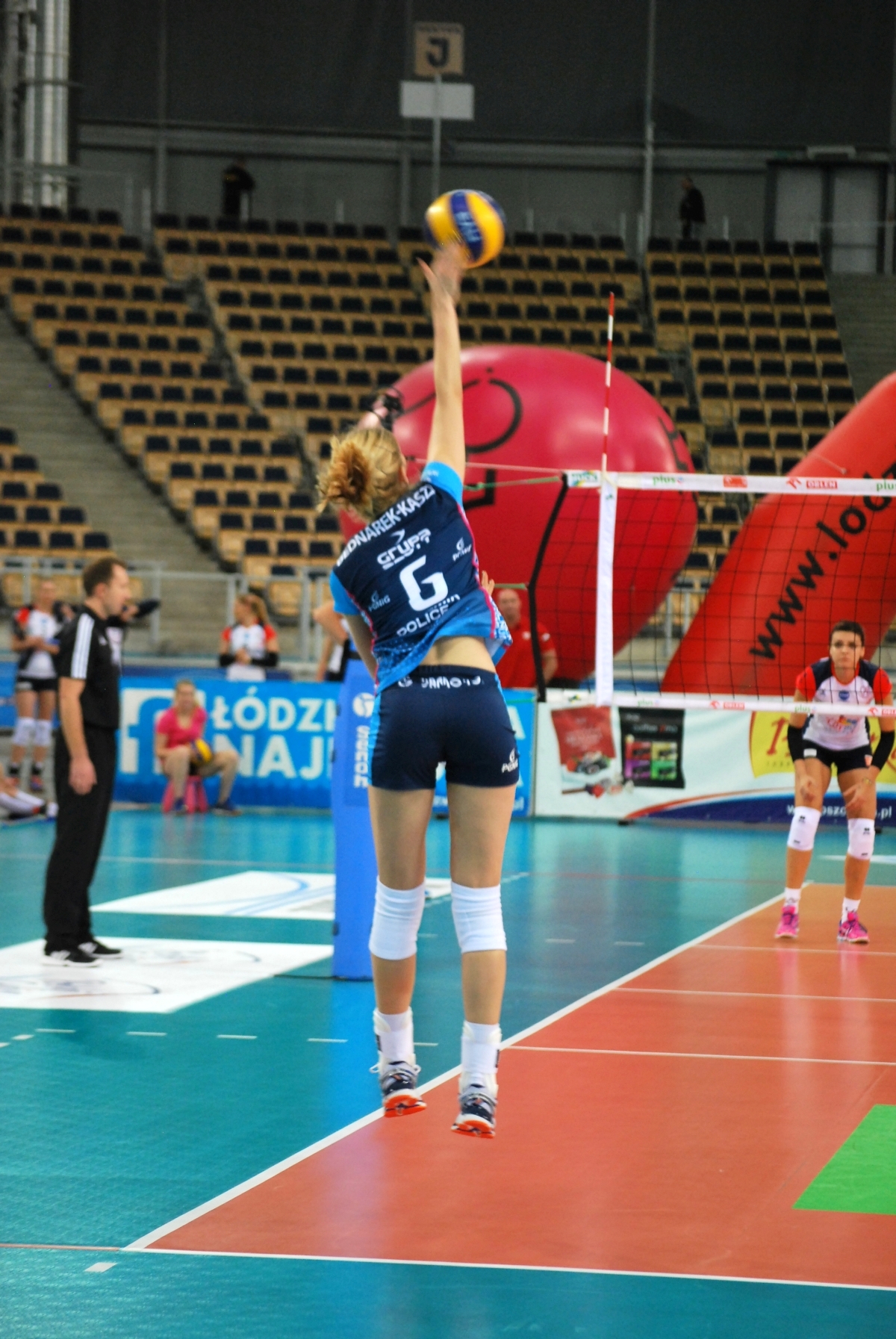 Bench Or Starter? 5 Volleyball Serving Mistakes Costing You Play Time
(Agnieszka jump float serve height by zorro2212)
Bench Or Starter? 5 Volleyball Serving Mistakes Costing You Play Time
(Agnieszka jump float serve height by zorro2212) ✓ Fix errors that keep you on the bench
✓ Practice efficiently with targeted solutions
✓ Track progress with professional checkpoints
✓ Access instantly—print or keep on device
✓ One-page format for quick reference
Your Personal Jump Float Serve Checklist
Before your next match, can you honestly check off each of these boxes?
□ I can execute my approach with consistent timing
□ My toss lands in the same spot 8/10 times
□ I contact the ball at or before my jump peak
□ I keep my wrist 'high-five' firm through contact
□ I can serve to all six (6) zones with accuracy
□ I have a backup plan when my jump float isn't working
If you can't check all these boxes yet, isn't it time to invest in perfecting your technique?
Click to Download Your Jump Float Volleyball Serve Mastery Checklist pdf:
🎯Jump Float Volleyball Serve Mastery Guide - $7
Are you attempting jump float serves but lacking the technical precision that creates consistent power and accuracy? Why Struggle with Jump Float Serves When You Could Master Them Systematically?
You'll Get:
Approach and Setup Methods --Master 3-step and 4-step approaches with optimal spacing and ball positioning
Jump and Timing Techniques -Perfect the slow-to-fast acceleration that creates maximum vertical lift and power
Ball Contact Fundamentals Learn the "high five" contact method for consistent float effect and accuracy
Landing and Follow-through Execute safe two-foot landings with proper hip rotation and shock absorption
Final Thoughts: Your Jump Float Serve Journey
Every D1 player, every professional, every Olympic server started exactly where you are now—learning how to jump float serve one rep at a time.
The difference?
They committed to the process.
In my 15+ years of coaching, I've never met a player who regretted investing time in perfecting their jump float serve.
But I've met hundreds who wished they'd started sooner.
Your Next Action Step
Tomorrow at practice, dedicate the first 15 minutes to your jump float serve.
Start with 10 approaches without the ball, then add your toss, then full serves.
Document your progress. Take pictures and video like I do with my private clients.
Because here's the truth:
In 30 days, you'll either have a weapon that changes your volleyball career, or you'll still be wondering "what if?"
Which will you choose?
Ready to accelerate your jump float serve mastery?
*Contact me for personalized coaching that transforms your serving game in just 5 sessions.
Because sometimes, the difference between good and great is having the right coach in your corner.
Ready to take your serving to the next level?
I help college-bound servers who've tried every tip but still struggle in matches master next-level serving confidence without mental breakdowns through personalized training that makes pressure serving feel routine.
My private training sessions are specifically designed for college-bound athletes who refuse to settle for "good enough" serving.
Limited spots available for serious players only.
If your athlete struggles with consistent serve receive, gets subbed out, or is overlooked for playing time—this is the fix you’ve been looking for.

Struggling with passing consistency?
I help talented passers tired of getting pulled from games because of inconsistent serve receive skills BUILD passing confidence without expensive private lessons using the same 3-step system that's helped dozens of my athletes get recruited.
Download my eBook for $17.99 and start building the passing confidence that keeps you on the court—and gets you seen by college coaches.
From Lady Vol to Legend: Coach April Produces Powerful Passionate Players...is that you?
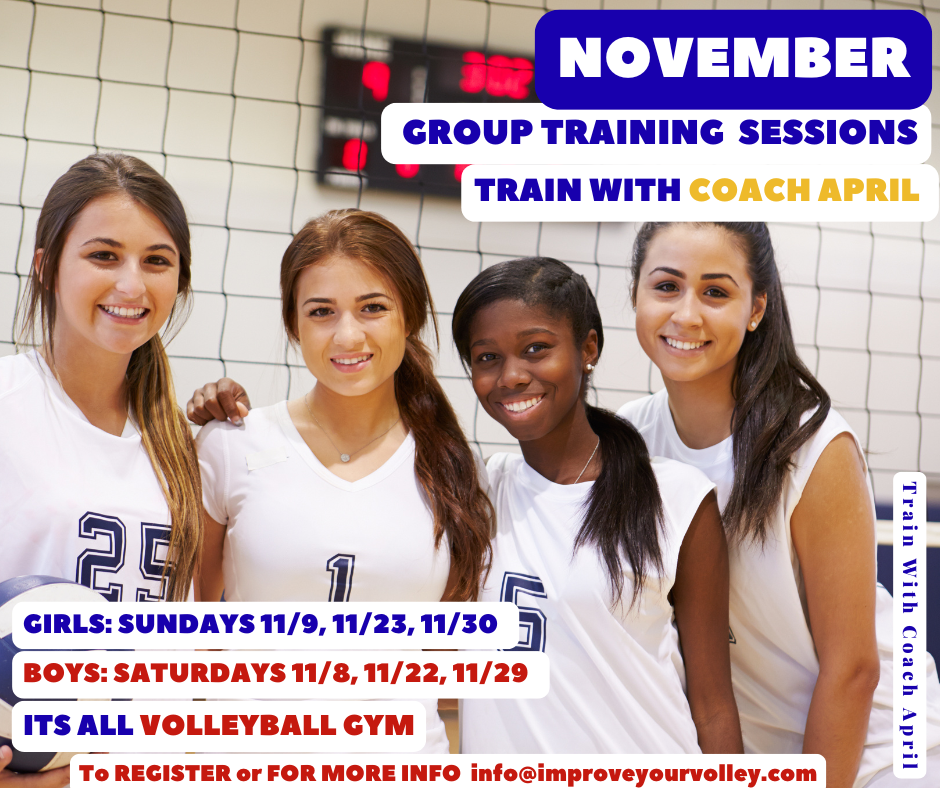
What Are You Looking For?
Click to Download Your Pre Serving Ritual Mastery Checklist pdf:
🎯Volleyball Pre Serving Ritual Guide -
Players! Learn How To Transform Your Serve from Weak to Weapon
Click to Download Your Parent's Volleyball Serving Checklist pdf
🎯Parent's Volleyball Serving Checklist Guide
Parents! Help Your Player Develop Championship Serves (Even If You've Never Played)

Hi there!
Thanks for stopping by. Hope you learned something today that will help you reach your volleyball goals.
Be sure to subscribe to my email newsletter so you can learn more each week!
Stay strong! Stay motivated!
-Coach April

SUSCRIBE to my email newsletter below!

 Click to learn more about the weekly volleyball classes and clinics or email info@imrpoveyourvolley.com for information
Click to learn more about the weekly volleyball classes and clinics or email info@imrpoveyourvolley.com for informationCongratulations to my seven Boys-18s Vegas Volley club players who played in two state championship finals yesterday, the 3A and 5A State champinship finals at Sunrise Mountain High School.
TOURNAMENT CHAMPIONS!
A-1 Vegas Volley VBC
In It To Win It Tournament
May 2 - 4, 2025 Tournament
Gold Medalists
18s Premier Division
Vegas Volleyball's Unsung Heroes: Celebrating Moms with Peace Love Volleyball Shirts
Ready to energize your volleyball mom journey?
Subscribe to my 'Producing Powerful Passionate Peaceful Players' email list above on ImproveYourVolley.com.
You'll receive energy-boosting tips, exclusive insights from me, Coach April Chapple on maintaining momentum in volleyball.
Let's power up the Vegas volleyball scene together!
Recent Articles
-
Volleyball Topspin Serve: How To Score Aces With Power and Spin
Nov 10, 25 03:10 PM
Want to add 3-5 aces per game? The volleyball topspin serve combines power and spin to score points. Learn the technique that makes passers fear your serve. -
5 Hitting Volleyball Drills Helping You Learn To Hit The Ball Harder
Nov 05, 25 12:33 PM
With these hitting volleyball drills, you have to adopt a fearless and aggressive attitude when it comes to spiking the ball against a two person block. -
Two Hitting Drills Volleyball Players Do To Learn To Beat The Block
Nov 05, 25 12:32 PM
Here are two hitting drills volleyball players use in our practices to teach our hitters how to beat the block while hitting or attacking at the net.
